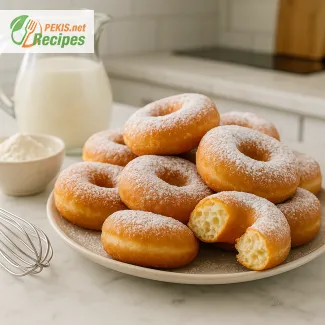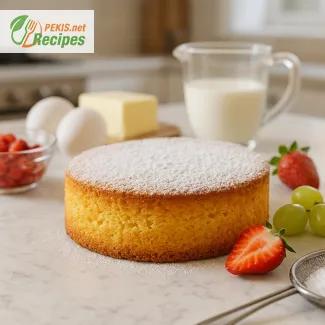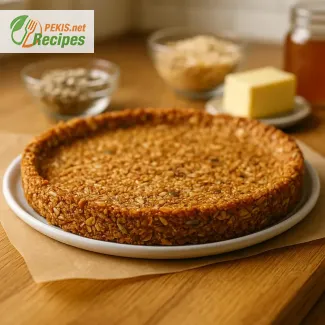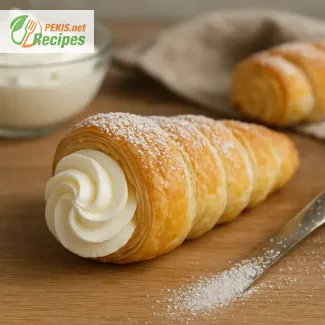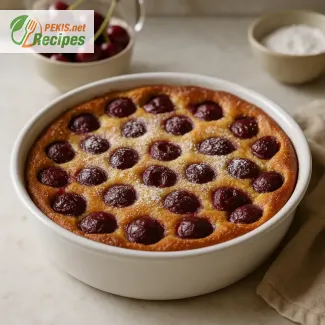
A classic French delight with a rustic twist
Discover the timeless charm of homemade cherry clafoutis
There’s something truly captivating about French rustic desserts — simple to prepare, yet rich in flavor and tradition. Among these, homemade cherry clafoutis holds a special place as a celebration of early summer and the fleeting beauty of fresh, ripe cherries. This elegant yet down-to-earth dish originates from the Limousin region of France and has long been cherished for its custard-like texture and warm, comforting essence. Made with just a handful of pantry staples and a generous helping of seasonal cherries, clafoutis is the perfect way to embrace the season’s bounty in a classic and utterly satisfying way.
With its golden, puffed edges and soft, flan-like center, cherry clafoutis strikes a beautiful balance between a baked custard and a pancake. Traditionally made with un-pitted black cherries, the original French method is said to enhance the almond-like aroma released from the stones during baking. However, modern adaptations often favor pitted cherries for ease of eating, without sacrificing the distinctive fruit-forward character of the dessert. The batter itself is a simple blend of eggs, milk, sugar, and flour, resembling a crêpe mixture, poured over the fruit and baked until set and slightly caramelized around the edges.
What makes this dessert truly shine is its versatility and natural sweetness. The cherries are the undeniable stars — ideally fresh, juicy, and slightly tart to offset the creamy base. While sweet dark cherries are most common, you can experiment with sour cherries for a tangier finish or even substitute with other stone fruits like apricots or plums when cherries are out of season. Each variation brings its own nuance, but none stray far from the spirit of the traditional French clafoutis.
Unlike elaborate pastries that require hours of prep and precision, cherry clafoutis invites an effortless approach. It’s a dish that feels both homely and refined, equally suited for a casual brunch or a summer evening dinner party. When served slightly warm, dusted with powdered sugar and perhaps accompanied by a dollop of whipped cream or a scoop of vanilla ice cream, it becomes an irresistible centerpiece that disappears in moments. The contrast between the soft custard and the baked fruit creates a mouthfeel that’s comforting, light, and gently decadent — never overwhelming, always inviting.
Another reason for its growing popularity is that it aligns beautifully with the slow living and farm-to-table philosophies. Preparing a clafoutis encourages you to focus on seasonal ingredients, simple techniques, and the joy of eating with intention. Whether you pick your cherries yourself or buy them fresh from a local market, there’s something ritualistic and grounding in assembling this dish. It doesn’t ask for perfection, just a touch of care and a good eye for ripeness.
Homemade clafoutis is also a delightful choice for those exploring French cuisine at home. It introduces the pleasures of traditional Gallic baking without the intimidation of puff pastry or pastry cream. It’s a wonderful entry point for both seasoned bakers and beginners, bringing a little piece of the French countryside into your kitchen. Plus, it stores beautifully and can be enjoyed warm or chilled — perfect for leftovers, though chances are there won’t be any.
Its ingredients, texture, and simplicity all contribute to its enduring appeal. As the days grow warmer and cherry trees begin to overflow with ripe fruit, clafoutis becomes more than just a recipe — it’s a seasonal ritual. A way to mark the passing of spring and the arrival of summer. A reminder that some of life’s greatest pleasures are best when they are least complicated.
Cherry clafoutis isn’t flashy, but it’s unforgettable. With each bite, you taste the essence of early summer — sweet, rich, and fleeting.
- Preheat your oven to 180°C (350°F). Lightly grease a round baking dish (approx. 22 cm / 9 inches) with unsalted butter. Set aside.
- Prepare the cherries. Wash and pit the cherries. Pat them dry with a paper towel and evenly distribute them across the bottom of the prepared baking dish.
- Make the batter. In a large mixing bowl, whisk together the eggs and granulated sugar until pale and slightly frothy (about 2–3 minutes). Add the vanilla extract, milk, and cream. Whisk until combined.
- Incorporate the dry ingredients. Sift in the flour and salt. Whisk until you achieve a smooth batter with no lumps. The consistency should resemble pancake batter.
- Assemble the clafoutis. Carefully pour the batter over the cherries in the baking dish. Make sure the fruit stays evenly distributed.
- Bake. Place the dish in the center of the preheated oven and bake for 35 minutes or until the clafoutis is puffed, golden, and set in the center. A toothpick inserted in the middle should come out clean.
- Cool and serve. Let the clafoutis cool for at least 10–15 minutes. Dust with powdered sugar before serving. Serve warm, at room temperature, or chilled.
Creative ways to enhance your homemade clafoutis recipe
Small ingredient tweaks that make a big difference in flavor and texture
The charm of a traditional cherry clafoutis lies in its simplicity: a custardy batter poured over fresh cherries and baked until golden. But as with many classic recipes, even the smallest adjustments can elevate it from good to unforgettable. Whether you're aiming to enhance the flavor, improve the texture, make it healthier, or adapt it to dietary restrictions, there's plenty of room for experimentation without losing the spirit of the original French dessert.
Choosing the best cherries for deeper flavor
One of the defining features of clafoutis is the fruit layer, and using the right cherries is essential. While sweet black cherries are commonly used, you can introduce a more complex flavor profile by mixing varieties. Combine sweet cherries with a handful of tart sour cherries to introduce a touch of acidity that balances the custard’s richness. If fresh cherries aren’t in season, high-quality frozen cherries (thawed and patted dry) can also be used with great success.
Avoid overly ripe or watery cherries, as they may release too much juice during baking, which can lead to a soggy texture. Roasting the cherries for 10 minutes before adding them to the dish can intensify their sweetness and reduce excess moisture.
Flavor-enhancing additions and alternatives
Vanilla extract is a traditional aromatic, but you can elevate the custard with almond extract for a more nutty finish that complements the cherry flavor. A teaspoon of kirsch (cherry brandy) or amaretto adds a sophisticated edge. For a more floral note, orange blossom water or rose water (used sparingly) can bring an unexpected and elegant twist.
You can also infuse the milk or cream with a vanilla bean pod or citrus zest before mixing the batter to give the custard more depth.
Alternative sweeteners and flours
To reduce refined sugar, try substituting coconut sugar, maple syrup, or honey (adjusting liquid ratios accordingly). These alternatives not only reduce the glycemic impact but also contribute a deeper, caramelized flavor.
Instead of plain all-purpose flour, try replacing it partially or fully with almond flour, which not only adds flavor but also results in a slightly denser, richer texture. Other options include spelt flour for a subtle nutty note or oat flour for a fiber boost. For a gluten-free version, use a certified gluten-free flour blend, but make sure to include a binding agent like xanthan gum for structure.
Dairy-free and plant-based substitutions
A traditional clafoutis relies on whole milk and cream, but plant-based alternatives can easily be used without compromising texture. Oat milk, almond milk, or soy milk work well as substitutes. Replace the cream with full-fat coconut milk or a plant-based cooking cream for similar richness.
For a vegan version, replace eggs with a blend of silken tofu, chia seeds, or a commercial egg replacer. While the result may be slightly less custardy, the flavor and structure can still be delightful when well balanced.
Tips for better baking technique
Even with perfect ingredients, technique matters. A common mistake is overmixing the batter, which can lead to a chewy texture. Gently whisk the ingredients until smooth, but avoid excess aeration. Another error is baking at too high a temperature, which causes the edges to brown before the center is set. Maintain a consistent temperature (typically 180°C / 350°F) and rotate the dish halfway through baking for even results.
Letting the batter rest for 30 minutes before baking allows the flour to hydrate and improves the overall structure. Additionally, dusting the greased baking dish with a light coat of sugar or ground almonds can prevent sticking and enhance the crust.
Serving and presentation upgrades
Serving clafoutis warm with a dusting of powdered sugar is classic, but small additions can make it special. Accompany it with a spoonful of crème fraîche, mascarpone, or Greek yogurt for creaminess. A drizzle of dark chocolate, caramel sauce, or even a few toasted almond flakes can transform the dish into an elegant dessert fit for any table.
If you want to impress guests, bake the clafoutis in individual ramekins for a charming presentation. Not only does this reduce the baking time, but it also ensures consistent portions.
Making it healthier without sacrificing flavor
If you're aiming for a lighter version, consider reducing the quantity of cream and using more milk instead. You can also reduce the number of eggs slightly, though you may need to adjust the flour to maintain structure. Use low-glycemic sweeteners, incorporate whole grain flours, and increase the fruit-to-batter ratio to emphasize freshness over richness.
Adding chopped nuts like pistachios or walnuts boosts texture and nutrition, while using low-fat dairy options can cut down on saturated fat content.
Why homemade is always better
Store-bought versions, if available, are rarely as satisfying as those made from scratch. A homemade cherry clafoutis allows you to control the quality of ingredients, ensure freshness, and tailor the flavors to your preferences. It also connects you more deeply with seasonal eating and traditional culinary methods, creating an experience that’s as fulfilling as the dessert itself.
Making this dish at home also allows for flexibility — whether you're preparing it gluten-free, reducing sugar, or showcasing a different type of fruit, the possibilities are endless. And above all, homemade desserts carry the warmth, aroma, and personal touch that no packaged product can replicate.
Allergens present in the recipe:
- Eggs
- Milk
- Gluten (from flour)
Tips for allergen-free alternatives:
- Eggs: Substitute with 3 tablespoons (45 ml) of unsweetened applesauce or a commercial egg replacer for each egg.
- Milk & cream: Use a plant-based milk (like oat or almond milk) and coconut cream or soy cream.
- Flour: Replace with gluten-free all-purpose flour mix or almond flour (note: texture may vary slightly).
- Vitamin A: 220 µg – supports eye health and immune function
- Vitamin D: 1.2 µg – essential for calcium absorption and bone health
- Calcium: 90 mg – important for bones and teeth
- Iron: 1.1 mg – helps carry oxygen in the blood
- Potassium: 180 mg – supports muscle function and fluid balance
- Magnesium: 14 mg – involved in over 300 biochemical reactions
- Vitamin C: 4 mg – boosts the immune system and acts as antioxidant
- Anthocyanins (from cherries): 100 mg – reduce inflammation and oxidative stress
- Vitamin C: 4 mg – scavenges harmful free radicals
- Polyphenols: 150 mg – support heart health and metabolic function
- Beta-carotene: 60 µg – protects cells and supports skin health
